Defence ministry’s ‘Buy Indian’ push delays army’s need for light tanks, infantry vehicles
Prasun K. Sengupta
The 12th edition of DefExpo 2022 held in Gandhinagar, Gujarat, revealed several shortcomings in the Indian Ministry of Defence’s (MoD) current L1-centric procurement processes that continue to pit the Buy Indian (India-designed-developed-make, or IDDM) category against the Buy & Make (Indian) category. This has caused severe delays in long-overdue planned procurements of the three services.
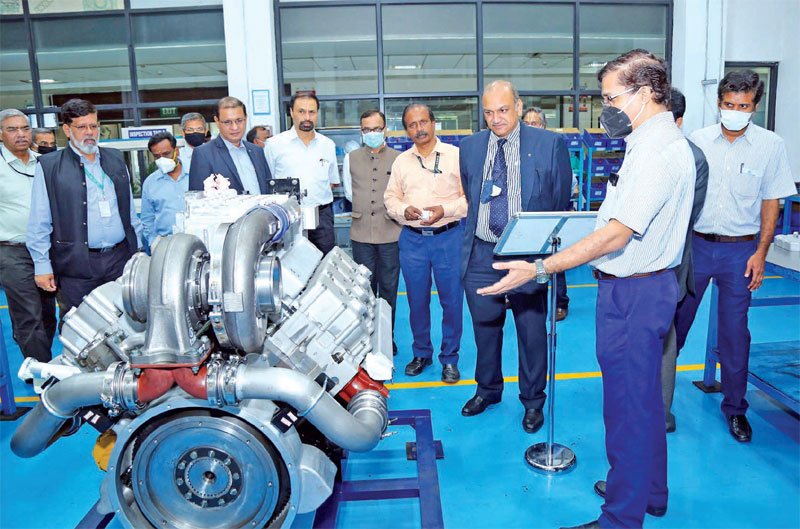
So much so that in August and October 2021, the then Chief of the Army Staff, General M M Naravane (retd) had called for both a rethink and drastic overhaul of the L1 concept under which contracts are awarded only to the lowest bidder.
Light Tank Saga
On April 22 last year, the army, under Project Zorawar, issued a request for information (RFI) for procuring 350 new-generation light tanks in a phased manner along with a related performance-based logistics package, niche technologies, engineering support package and other maintenance and training requirements. This was to be a Make-1 (Indian) procurement category of the Defence Acquisition Procedure (DAP) 2020. While the RFI mandated that the Indian development agency retain the ownership of the design and technologies (intellectual property rights) for the platform, the army stipulated that the direct import of such tanks will be prohibited from 2025 onwards.
Meanwhile, the Defence Research & Development Organisation (DRDO) has been working with Larsen & Toubro (L&T) on developing a 25 metric tonne light tank under the ‘Make-1’ category in which the industrial OEM receives R&D funding to the tune of 90 per cent from the MoD. This is released in a phased manner based on the progress of the scheme as per the terms agreed between the user and the OEM. In April 2021, the army’s Directorate General of the Armoured Corps finalised its Preliminary Staff Qualitative Requirements (PSQR), which detailed the precise specifications of the tank. Thereafter, the DRDO’s Avadi-based Combat Vehicles R & D Establishment (CVRDE) was tasked with designing the end-product in November 2021, with a deadline of three years. The CVRDE-L&T team has been directed to complete the product development and user-trial phases by November 2024.
Jayant D Patil, who currently serves as adviser to L&T chief executive officer and managing director S N Subrahmanyan, said during the expo that the 25 metric-tonne tank, a completely ab initio design, will feature an unmanned turret containing an ammunition autoloader, will have a three-man crew, and its first prototype will roll out next June. The tank’s diesel engine and transmission will be bought off-the-shelf and are likely to be the MTU Friedrichshafen-built MT881Ka-500 8-cylinder water-cooled diesel engine rated at 1,000hp, and the SNT Dynamics/Allison Transmission X1100-5A3, both of which are already in use by the army’s L&T-delivered K-9 Vajra-T 155mm/52-calibre tracked self-propelled howitzers.
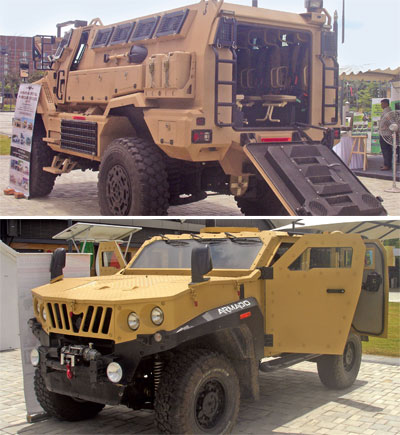
Mahindra ALSV
Armoured protection will be modular with bolt-on armour plates providing protection of STANAG-4 level in the tank’s frontal 60-degree arc and STANAG-2 elsewhere. It will have a 105mm new-design rifled-bore cannon and a power-to-weight ratio of 30hp/tonne. At the expo, L&T showcased a scale-model of its light tank concept. But Patil clarified that while L&T is involved in such an R&D effort, it is not assured of any role in the bulk production phase, meaning the Indian process cannot place development and production contracts in on go. “Developed equipment has to undergo field evaluation trials and emerge successful for the induction clearance, and only then the production ordering process begins,” he explained.
Interestingly, the Kalyani Group’s Bharat Forge subsidiary was also showcasing a design of its light tank concept, albeit only through a video presentation. All of this raise a number of questions. If the light tank’s design and development efforts are totally indigenous by the CVRDE-L&T team, then why is it not coming under the Buy Indian (IDDM) category? Is it not bizarre that the MoD has accorded only a four-year timeframe for prototype development when the global norm is a minimum of six years? Is it even realistic to mandate a maximum combat weight of 25 metric-tonnes when OEMs from China the US, UK, Germany, Poland and South Korea that have already developed light tanks feature designs whose weights range from 30 to 38 metric-tonnes with power-to-weight ratios ranging from 25 to 33hp/tonne?
It is perhaps because of such unrealistic R&D expectations and timeframes, plus impossible to achieve performance parameters that encouraged Russia’s Rosoboronexport to state that it continues to offer its Sprut-SDM1 light amphibious tank to the army, while Israel’s Elbit Systems at the expo was promoting its Sabrah light tank solution based on the tracked ASCOD platform that is manufactured by Spain-based General Dynamics European Land Systems Santa Bárbara (GDELS). The 30 metric-tonne Sabrah comes equipped with a 105mm cannon and subsystems that include a proven optronic day/night sight, digital fire-control system, TORCH-XTM battle management system, E-LynXTM software defined-radio systems and life-support systems.
There was also no clarity from either the Indian or foreign OEMs exhibiting at the expo about the future course of action regarding the army’s futuristic requirement for a new-generation main battle tank (MBT), that is a Future Ready Combat Vehicles (FRCV), approximately 1,770 of which are planned for procurement in a phased manner, with envisaged service-induction by 2030. The FRCV family will comprise the futuristic MBT or FMBT and its supporting armoured bridge-layers and engineering and recovery vehicles.
As per the RFI issued in May 2021 by the army, the FRCV is planned to be procured under the Strategic Partnership (SP) route under which an Indian private-sector OEM will have to partner with a foreign OEM for coming up with the required solution. The latest RFI supersedes an earlier RFI issued on November 8, 2017, on the same subject. As per the latest RFI, the FRCV will remain in service as the MBT with the army for the next 50 years. It will be required to operate in varied terrain profile (high-altitude areas, plains, riverine terrain, deserts/semi-deserts) across the current and future spectrum of conflict, will be manned either by two or three-man crew and will have a desirable combat weight of about 50 metric-tonnes when being powered by an indigenously-developed 1,500hp powerpack. But in some of the five positive indigenisation lists issued by the MoD thus far, the corporatised MoD-owned Armoured Vehicles Nigam Ltd (AVANI) is required to series-produce the Arjun MBT’s Mk 2 and Mk 3 variants and their powerpacks by December 2027.
FICV Saga
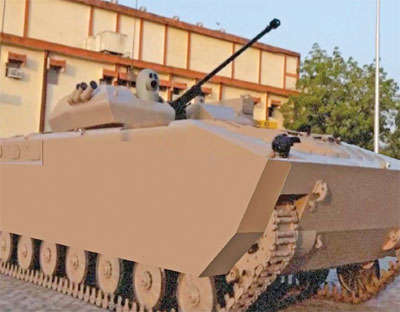
The army’s planned procurement of 2,600 futuristic tracked infantry fighting vehicles (FICV) in various versions worth Rs 60,000 crore (to eventually replace the 2,610 BMP-2 Sarath ICVs) remains an illusion marred by frequent changes in procurement methodologies and bureaucratic apathy, despite the MoD according the acceptance of necessity (AoN) back in October 2009 (under the ‘Make’ category of DPP-2008).
Of the four contestants that submitted proposals in October 2010, Tata Motors. Mahindra Defence, L&T and the then MoD-owned Ordnance Factory Board (OFB), the MoD was to select two of them as ‘Development Agencies (DA),’ who were to each design and build a prototype of the FICV. The better one was next to be selected as the final FICV design, which was then to go into bulk production. The MoD was to fund 80 per cent of the cost of developing each prototype (with the Indian DAs funding the remaining 20 per cent) that were mandated to be at least 30 per cent indigenous. But this exercise came to an abrupt end by 2014 and was followed by an expression of interest (EoI) being issued by the army in November 2016.
In 2018, the FICV project was shifted to the Make-II category (of DPP-2016) to involve private-sector OEMs in this project under the ‘Make in India’ initiative under the SP route. As per the DPP-2008, in the Make-II category no R&D funds are required from the MoD whereas under the Make-1 category 90 per cent of the funds up to the prototype stage has to come from the MoD. In 2016, under the Make-1 category, three DAs were planned for shortlisting, which included two from the private-sector and AVANI. The MoD was supposed to give a minimum Rs 500 crore each to the three DAs. The army was asked by the MoD to seek a detailed project report (DPR) from all the contenders who had received the EoI in 2016. By then the project, which was already delayed by a decade, got stalled further. The Integrated Project Management Team (IPMT), which was to seek reports from all the companies that had responded to the revised EoI took more than a year.
On 7 March 2016, Tata Motors inked a strategic industrial partnership agreement with Bharat Forge Ltd and US-based General Dynamics Land Systems (GDLS) for collaborating on the FICV project. Tata Motors leads the consortium, with Bharat Forge as a partner, while the GDLS brings in its much-proven expertise as a system of systems integrator (SOSI). Tata Motors is playing on its strengths related to design, development and integration of high/heavy-duty mobility platforms, while Bharat Forge has brought on board its competence with fighting platforms and manufacturing strengths.
The conceptual FICV design of this consortium features anti-armour guided-missiles with 4 km-range and a crew of three while carrying eight combat-kitted infantrymen. The FICV will be mobility-oriented and this is established by the fact that three of the five core technologies and 19 of the 34 critical technologies are mobility-related, such as engines, transmission and running gear, which are core to Tata Motors. But since then, this consortium has not rolled out any FICV prototype to date and both Tata Aerospace & Defence and Bharat Forge were tight-lipped about this project at DefExpo-2020.
On 23 June 2021, for the third time, the army issued a fresh RFI for FICVs, this time for 1,750 tracked FICVs, or FICV (Tr), in three versions: FICV (Tr) gun version that will account for approximately 55 per cent of the total quantity to be ordered, FICV (Tr) command version, making up approximately 20 per cent of total quantity, and ICV (Tr) command and surveillance version, making up approximately 25 per cent of total quantity. Indian OEMs are required to commence supplies of the FICV (Tr) within two years of the contract award at a rate of between 75 and 100 vehicles per year.
The FICV (Tr) should be modular in design, thereby lending itself to future upgrades through simple modifications and to facilitate the subsequent development of a family of armoured fighting vehicles (AFV) like the command-in-control ICV variant, armoured personnel carrier (APC), armoured ambulance, mortar carrier, command post vehicle, reconnaissance-in-surveillance vehicle, CBRN reconnaissance vehicle, engineer reconnaissance vehicle, armoured recovery vehicle and short-span bridge-laying vehicle. The army has specified that the FICV have a 30hp/tonne power-to-weight ratio and a combat load (ammunition and stowage items) of 2.5 metric-tonnes.
The FICV should also come equipped with canister-launched loitering precision-guided munition (L-PGM) capable of observing, identifying and destroying non line-of-sight (NLOS) targets with all-the-way man-in-loop control and lock-on after launch (LOAL) features to be provided in the FICV(Tr) command and FICV(Tr) command & surveillance variants. The range of the data-link should be at least 10km with a loiter time of at least 60 minutes. The FICV(Tr) variants should also be capable of firing at least 30mm calibre ammunition both in direct firing and anti-aircraft roles.
During the expo, it emerged that the CVRDE-L&T has been developing, since 2017, a FICV family, which, if ordered, will be bulk-produced at L&T’s first private-sector armoured systems complex (ASC) at Hazira, Gujarat. According to L&T, the ASC can be used to build and perform integration activities on tracked self-propelled artillery howitzers, FICVs, FRCVs, FMBTs 8 x 8 wheeled armoured platforms (WhAP). The full-scale conceptual FICV built by L&T made its debut at the expo and it features a hull and turret built completely with lightweight composites-based materials, and a 40mm cannon mounted on the unmanned turret.
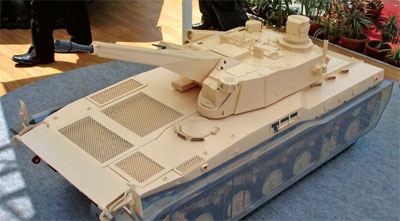
In the mobility-protection-fire power triumvirate of armoured vehicles the emphasis is very much for mobility, as these vehicles have to manoeuvre away as quickly as possible in crisis. At the same time an FICV has to be equipped with advanced protection systems to cater for even the latest threats. At present, a major portion of an ICV like the BMP-2 is made of rolled homogeneous armour (RHA) steel, while the frontal portion, which has high threat possibility, has a multi-layered complex sandwich type of construction rather than thick monolithic steel.
Additionally, it has the semi-active type explosive reactive armour (ERA) option. As a result, the vehicle weight has increased considerably. For increased mobility, the vehicle should weigh less. However, the enhanced protection, improved firing capability and advanced features like laser warning countermeasure system, mine-plough and see-through armour augmented reality vectronics have tremendously increased the ICV’s weight. This unintended increase in weight reduces the vehicle’s efficiency/ performance. This issue can now be solved by the use of composite materials that have high specific properties compared to conventional metals and alloys so that suitable replacements will result in considerable weight reduction. As part of attempts to replace the high-density steel, structural components like hatches, protective panels, louvers and the dynamic components like road-wheels and top-roller for the FICV have been developed by the CVRDE using composite materials, which also increases the structural and ballistic efficiency of the hull.
Worldwide, extensive R&D is currently in progress to use polymer-matrix composite materials for structural and dynamic purposes. The dynamic components like road-wheels and top-rollers have been successfully developed using carbon fibre-epoxy composites. The strength of components built with composite materials can be increased even more with the proper use of fabric and resin. Also, the ride performance can be further improved with improved distribution of materials in composite components. The negative aspects of composite materials can be overcome by proper use of additive material like fire-resistant materials and coatings. Glass-reinforced plastic-based composite material is a poor transmitter of sound, with its damping capacity being attributed to the fibre-matrix interface. A reduction in radiated noise leads to lower crew fatigue, and a lower acoustic signature for the vehicle.
The only other Indian OEM known to be developing FICV family is AVANI, which did not showcase its conceptual prototype at the expo, opting instead to show an audio-visual presentation of its proposed solution that will be powered by a CVRDE-developed 600hp diesel engine coupled to an Allison-supplied transmission.
WhAP Saga
The DRDO’s Vehicle R&D Establishment (VRDE) along with Tata Motors has developed the multi-role 8 x 8 wheeled armoured platform (WhaP) as a basic vehicle for a family of mobile, protected, multi-purpose vehicles, including a command post vehicle; reconnaissance vehicle for a chemical, biological, radiological and nuclear (CBRN) battlefields; and an amphibious reconnaissance vehicle, APC, and a light, armoured ambulance. Weighing up to 26 metric tonnes, it is amphibious, that is it is capable of floating, comes with a hydrogas suspension, and a 600hp Cummins diesel engine coupled to an Allison transmission that offer a power-to-weight ratio of 26.6hp/tonne.
Armoured protection is modular, with bolt-on, retrofittable panels that provide protection up to a level of STANAG-4. The floor can be reinforced to resist an improvised explosive device (IED). In addition, wish-lists prepared for various United Nations peacekeeping/ peacemaking missions have been recycled into the WhaP. The primary armament is a 30mm 2A42 cannon (same as on the BMP-2), mounted on a turret (same as that of the BMP-2) with an upgraded TIFCS day/night sighting system developed by Elbit Systems and supplied by Indian OEM Alpha Design Technologies. The DRDO has thus far chosen Tata Motors as its ‘design-cum-production partner’ (DCPP), but given the large number of WhAPs to be procured in future, other Indian OEMs like L&T and Mahindra Defence are most likely to be enrolled as DCPPs. All three OEMs showcased their respective variants of the WhAP at the expo.
On 22 November 2019 the army, under the IDDM category, issued an RFI for procuring quantity 198 WhAP recce and support variants (WhAFV R & Sp) for employment by the army’s R & Sp (Wh) battalions in Punjab and Rajasthan. The RFI specifies that the chosen OEM should supply the 198 vehicles within four years of contract signature. The powerpack must have a power-to-weight ratio of a minimum of 25hp/tonne, while the vehicle must be air-transportable by the Indian Air Force’s (IAF) transport aircraft and in-service rail wagons (Bogie Open Military, Military Bogie Well types). It should have a four-man crew, and be armed with two twin launchers containing cannister-encased, infra-red guided, fire-n-forget anti-armour guided-missiles ATGM with tandem warheads to achieve a minimum penetration of 650mm of RHA beyond ERA day, digital hunter-killer day/night fire-control system, hit probability of more than 90 per cent, minimum achievable range not more than 500 metres and maximum range not less than 4km in direct-firing mode. Also, provision of a man-portable ATGM launcher capable of firing the same type of ATGMs as mounted on the Wh AFV R & Sp is sought. The turret should house a 30mm cannon and 7.62mm co-axial machine gun (both capable of firing in-service ammunition, with an RCWS being desirable. Also required is the internal stowage of 500 rounds of 30mm ammunition and 2,000 rounds of 7.62mm ammunition.
Meanwhile, the MoD-owned Bharat Earth Movers Ltd (BEML) has called for foreign OEMs to provide a 8×8 vehicle solution in response to the IA’s RFI for supplying 198 such vehicles. The army’s RFI calls for procuring 198 WhAP recce and support variants for use by its R & Sp (Wh) Battalions. In addition, the army has begun procuring an initial 89 8×8 improved protected mobility vehicle (IPMV) variants armed with 12.7mm Akord heavy machine gun-equipped remote-control weapon stations (RCWS) and in future wants to procure 8×8 WhICVs capable of carrying 10 fully-equipped troops, and 8×8 WhAFVs armed with unmanned turrets containing NLOS anti-armour guided-missiles (most likely the Rafael-supplied Spike-NLOS missile). The MoD had earlier mandated that the import of WhAPs be terminated by December 2021.
Other Procurements
On June 30 this year, the army issued an RFI calling for procuring 800 light armoured multipurpose vehicles (LAMV) in two versions for its mechanised infantry and armoured corps formations. It wants delivery of these LAMVs within 36 months of contract award at a rate of 300 vehicles per year. The LAMV Version-1 will be employed by reconnaissance and surveillance platoons of mechanised infantry and recce troops of the armoured corps for recce and surveillance tasks at high altitude (up to 5,000 metres above mean sea-level), over mountainous terrain, including snow-bound areas as occurring along India’s northern borders in eastern Ladakh and north Sikkim).
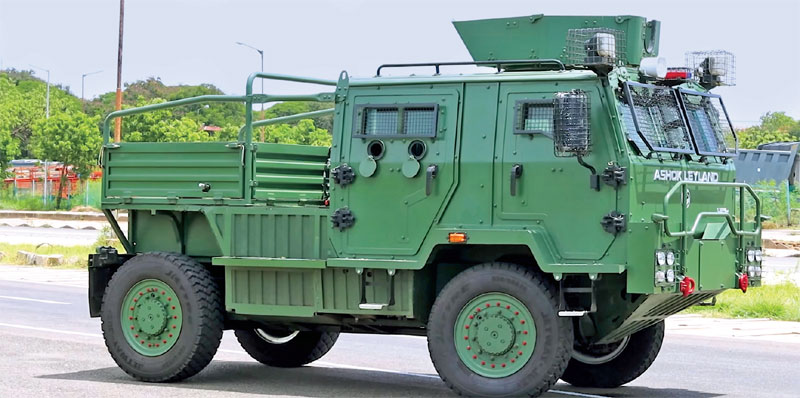
The LAMV should be a 4×4 right-hand drive vehicle with protection of STANAG-I level all around the vehicle to include its underbelly, doors, windscreen and window glasses. It should be able to integrate surveillance equipment (in-service battlefield surveillance radar-medium and uncooled hand-held thermal imager) on a telescopic retractable mast, plus a 7.62mm medium-machine gun mounted on a hatch/ cupola (with 360 degree traversing capability) for bringing down effective fire. In addition, it should have modular racks/brackets for effective stowage of battle and personal loads of crew. The shelf-life of the LAMV should not be less than 10 years/ 1,00,000km. The LAMV Version 1 must be air transportable by the IAF’s IL-76MD, C-17A C-130J-30 transport aircraft and by broad-gauge railway military bogie.
The LAMV Version-2 should be a 4×4 right-hand drive vehicle with protection of STANAG-II Level all around the vehicle to include its underbelly, doors, windscreen and window glasses. It should be able to integrate new-generation surveillance and targeting sensors like integrated surveillance and targeting system and continuous tied surveillance system and provide RCWS for in service 12.7mm Akord heavy machine gun mounted on a hatch/cupola (with 360 degree traversing capability) for bringing down effective anti-aircraft and ground-fire. The LAMV Version-2 should also have modular racks/brackets for effective stowage of battle and personal loads of crew.
The preferred LAMV solution by the army is most likely the Kalyani M4 (originally developed by South Africa’s Paramount Group), which is a ‘Quick-Reaction Fighting Vehicle (Heavy)’, licence-built by Bharat Forge and capable of carrying an infantry section (10 soldiers) in full combat gear. The Kalyani M4 last year successfully completed a series of extreme mobility trials in the freezing terrains of Leh and Ladakh, and the unforgiving deserts of Rann of Kutch. It has ballistic and blast protection from up to 50kg TNT side-blast or roadside IEDs due to its design that is built on a flat-floor monocoque hull. With a thrust speed of 140kph, the M4 has a payload of 2.3 tonnes. Bharat Forge has been able to carry out indigenisation of nearly 95 per cent of the vehicles, with only 5 per cent being imported from abroad. With a combat radius of approximately 800km, the Kalyani M4 is powered by a 460hp Cummins diesel engine. The army last year placed an order for an initial 45 Kalyani M4s, while another 23 APCs were handed over to its units that have gone into UNPKOs. The former is now being armed with Spike-NLOS ATGMs. While its Pune-based plant has the capacity to build 40 vehicles per year, Bharat Forge plans to ramp it up to 100 soon, and not limited to just the M4s.
The army on May 22 this year released two RFIs for procuring protected mobility vehicles (PMV). One RFI calls for approximately 700 PMV Standard (S) variants for deployment below 4,000-metre altitude, while the other intends to procure about 500 PMV High Altitude (HA) variants for deployment above 4,000 metres. Both PMV (S) and PMV (HA) should be wheeled, 4×4 drive mode vehicles with automatic transmission. They both should facilitate carriage of minimum 10 personnel, each with combat loads of at least 30kg, excluding driver and co-driver. The payload capacity must be a minimum of 2 metric-tonnes. The vehicles must have minimum 350mm ground clearance and the capability to ford water bodies over 1-metre deep. Vehicle speeds must not be less than 80kph on-road and 40 kph off-road. Frontrunners for bagging these contracts are Tata Advanced Systems Ltd (TASL) and Bharat Forge. Last July, the army took delivery of an undisclosed number of 4×4 Quick Reaction Fighting Vehicles (QRFV) from TASL and since then they have been deployed in both eastern Ladakh and northern Sikkim.
In March 2021, Mahindra Defence Systems Ltd (MDSL), bagged a massive order worth Rs 1,056 crores (USD146 million) from the army for supplying 1,300 armoured light specialist vehicles (ALSV) for its recce and support units. Deliveries began the same year and will be completed by 2024. The ASLV offers ballistic protection of up to B7, STANAG Level II. It provides protected mobility for front, side and rear as per STANAG Level I ballistics and blast standards for four crew members. It can also be upgraded up to STANAG–II Ballistics. The ALSV has ample storage area for arms and ammunition inside the crew compartment. It also offers an additional 400kg capacity for carrying cargo. The ASLV is powered by a 3.2-litre inline six-cylinder turbocharged diesel engine, which delivers 215bhp at 3,600rpm and a peak torque of 500Nm at 2000rpm. The engine can be paired with either a four-speed automatic or a six-speed automatic gearbox. A 4WD setup with front and rear differential locks are offered as standard. It can clock a top speed higher than 120kph and can sprint from 0kph to 60kph in 12 seconds. Total payload capacity is 1,000kg, inclusive of a self-recovery winch. Further, it is equipped with high travel all-wheel independent suspension and a central tyre inflation system. It runs on 318/80 R17 section tyres that are designed to run flat on all five wheels for 50km as per FINABEL standard. A version of this ASLV from MDSL has already been deployed with the Indian Battalion at the UN Peacekeeping mission in Africa.
In April 2021 Ashok Leyland Ltd began delivering its first batch of light bulletproof vehicles (LBPV) to the IAF. The LBPV is an adopted version of Lockheed Martin’s Common Vehicle Next Gen (CVNG) and has been developed under transfer of technology since 2014 from Lockheed Martin to Ashok Leyland. It has been completely indigenised and developed in India. On May 19 this year, the MoD issued another RFI for procuring an additional 1,500 ASLV-GS 4×4 weighing between 700kg and 900k for use by the three armed services. The vehicles will be used in general service roles in the hills, at high altitudes, in snow-bound areas, plains and desert and any other terrain as prevalent in the country. The vehicle should employ contemporary technology in all its systems to deliver best performance and reliability.
It should be able to perform optimally in desert, cross-country, high-altitude terrain not less than 5,000 metres above mean sea level. The selected solution will gradually replace the roughly 35,000 Maruti-Suzuki Gypsy 4 x 4s currently in service. In a related development, the army has imported an undisclosed number of MRZR Alpha all-terrain wheeled vehicles from US-based POLARIS. These vehicles have a maximum speed of 96kph, a gross vehicle weight of 2,308kg and a maximum payload of 907kg. The Alpha features a 118hp diesel engine with eight-speed transmission.

